Quadratic equations appear often in algebra, and they need to be solved! The quadratic formula helps you to do this – but sometimes it is confusing to remember the difference between these two ideas.
So, what is the difference between a quadratic equation and the quadratic formula? A quadratic equation has the standard form ax2 + bx + c = 0, and it can have two real solutions, one real repeated solution, or two complex conjugate solutions. The quadratic formula uses the coefficients a, b, and c from the quadratic equation to help us find these solutions.
Of course, there are other ways to solve a quadratic equation, such as completing the square. In fact, the quadratic formula is a shortcut for this method!
In this article, we’ll take a closer look at the difference between a quadratic equation and the quadratic formula. We’ll also look at some examples and how to apply the equation in different scenarios.
Let’s get going.
Quadratic Equation vs Quadratic Formula
There are many possible quadratic equations (in fact, there are infinitely many!). However, there is only one quadratic formula.
The amazing thing is: no matter which quadratic equation you choose, the quadratic formula will tell you the solutions (you can learn more about what the solutions of a quadratic formula represent in my article here).
There are three basic cases for the solutions when solving a quadratic equation (more on this later).
For now, let’s start with quadratic equations: what they are, what they look like, and how to recognize them.
What Is A Quadratic Equation?
A quadratic equation is an equation that can be rearranged (using rules of algebra) into the form
- ax2 + bx + c = 0 (where a is not zero).
The form above is known as the standard form of a quadratic equation. This is the form where one side of the equation is zero, and all other terms are gathered on the opposite side.
A quadratic equation contains only second-degree polynomials. This means that the highest power of the variable x is 2.
If we have a quadratic equation that is not in standard form, we can rearrange it into standard form by subtracting terms from both sides until one side is zero.
Examples of Quadratic Equations
Here are a few examples of quadratic equations, some of which have zero coefficients.
Example 1: Quadratic Equation (All Three Coefficients Nonzero)
The equation 3x2 – 5x + 2 = 0 is a quadratic equation in standard form (since the right side is equal to zero).
In this case, we have a = 3, b = -5, and c = 2, so all of the coefficients are nonzero.
Example 2: Quadratic Equation (Zero Constant Term)
The equation 7x2 + 6x = 0 is a quadratic equation in standard form (since the right side is equal to zero).
In this case, we have a = 7, b = 6, and c = 0, so one of the coefficients (c) is zero.
Example 3: Quadratic Equation (Zero Linear Term)
The equation 8x2 + 9 = 0 is a quadratic equation in standard form (since the right side is equal to zero).
In this case, we have a = 8, b = 0, and c = 6, so one of the coefficients (b) is zero.
Example 4: Quadratic Equation (Non-Standard Form)
The equation 11x2 – 4x – 2 = 5 is a quadratic equation, but it is not in standard form (since the right side is equal to 5, not zero).
To convert it to standard form, we need to subtract 5 from both sides. This leaves us with
11x2 – 4x – 7 = 0
Now, we have a quadratic equation in standard form, with a = 11, b = -4, and c = -7, so all of the coefficients are nonzero.
Example 5: Quadratic Equation (Non-Standard Form)
The equation 3x2 + 7x – 3 = x2 + 2x + 6 is a quadratic equation, but it is not in standard form (since the right side is equal to x2 + 2x + 6, not zero).
To convert it to standard form, we need to take a few steps:
- 3x2 + 7x – 3 = x2 + 2x + 6 [original equation]
- 2x2 + 7x – 3 = 2x + 6 [after subtracting x2 from both sides]
- 2x2 + 5x – 3 = 6 [after subtracting 2x from both sides]
- 2x2 + 5x – 9 = 0 [after subtracting 6 from both sides]
Now, we have a quadratic equation in standard form, with a = 2, b = 5, and c = -9, so all of the coefficients are nonzero.
Examples Of Equations That Are Not Quadratic
Here are a few examples of equations that are not quadratic.
Example 1: Non-Quadratic Equation (Zero Quadratic Term)
The equation 4x + 2 = 0 is not a quadratic equation, since its order is 1, not 2. There is no x2 term (or rather, the coefficient of the x2 term is zero).
This means that the order of this equation is 1, since 1 is the highest power of x that appears in the equation.
Example 2: Non-Quadratic Equation (Order Too High)
The equation x3 + 8x = 7 = 0 is not a quadratic equation, since its order is 3, not 2. The highest power of x that appears in the equation is 3.
(Not to mention the fact that there is no x2 term in the equation at all!)
Example 3: Non-Quadratic Equation (Order Too High)
The equation 2x3 + x2 – 4x + 5 = 0 is not a quadratic equation, since its order is 3, not 2. The highest power of x that appears in the equation is 3.
Although this equation does have an x2 term, the presence of 2x3 means the equation is cubic, not quadratic.
Example 4: Non-Quadratic Equation (Non Polynomial)
The equation 2x = x2 + 4x – 3 is not a quadratic equation, since it has an exponential term of 2x. Although we do have a quadratic expression on the right side of the equation, the equation itself is not quadratic (in fact, it is not even a polynomial!)
What Is The Quadratic Formula?
The quadratic formula is a generalized rule that helps us to find the solutions of a quadratic equation.
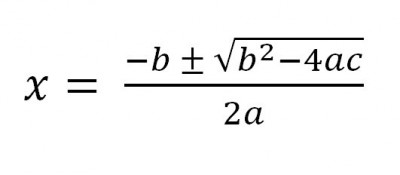
The great thing about the quadratic formula is that it works to solve any quadratic equation you can think of.
The drawback is that you will need to use both fractions and radicals, both of which can be error-prone when rushing through calculations. It may sometimes be easier to use factoring to solve a quadratic equation.
If you use the quadratic formula, there are 3 possible cases for the solutions of a quadratic equation:
- 1.) Two Real Solutions (Two Distinct Real Roots) [Positive Discriminant]
- 2.) One Real Solution (One Repeated Real Root) [Zero Discriminant]
- 3.) Two Complex Solutions (Two Distinct Complex Conjugate Roots) [Negative Discriminant]
Remember that the discriminant of the quadratic formula is the term b2 – 4ac, which is found under the radical (in the numerator of the fraction).
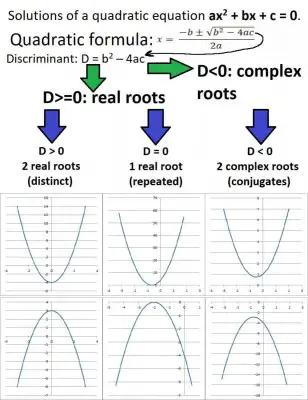
Where Does The Quadratic Formula Come From?
The quadratic formula is a shortcut for the method of completing the square. In fact, the quadratic formula is derived by completing the square for the standard form of the general quadratic equation ax2 + bx + c = 0.
Solving A Quadratic Equation By The Quadratic Formula
You can solve any quadratic equation by using the quadratic formula. Your solutions can vary quite a bit, since you can get:
- Integer solutions (whole numbers with no fractions or decimals)
- Rational solutions (fractions with no radicals)
- Irrational solutions (with radicals)
- Complex solutions (with an imaginary part)
Let’s take a look at each of these cases.
Example 1: Two Real Solutions (Integer Solutions)
Take the quadratic equation x2 – 3x + 2 = 0. Then we have a = 1, b = -3, and c = 2.
Substituting into the quadratic formula, we get

This reduces to (3 +/- 1) / 2, or x = 2 and x = 1. This quadratic equation has two real solutions (which happen to be positive integers).
Example 2: Two Real Solutions (Rational Solutions)
Take the quadratic equation 6x2 –5x + 1 = 0. Then we have a = 6, b = -5, and c = 1.
Substituting into the quadratic formula, we get

This reduces to (5 +/- 1) / 12, or x = 1/2 and x = 1/3. This quadratic equation has two real solutions (which happen to be positive rational numbers).
Example 3: Two Real Solutions (Irrational Solutions)
Take the quadratic equation x2 + 3x + 1 = 0. Then we have a = 1, b = 3, and c = 1.
Substituting into the quadratic formula, we get

This reduces to
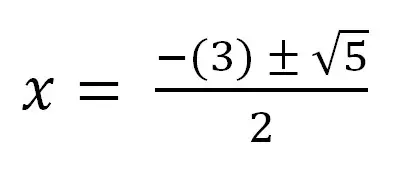
or
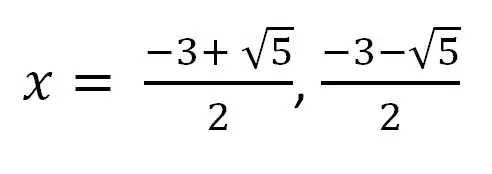
This quadratic equation has two real solutions (which happen to be irrational numbers).
Example 4: One Real Solution (Repeated Root)
Take the quadratic equation x2 + 4x + 4 = 0. Then we have a = 1, b = 4, and c = 4.
Substituting into the quadratic formula, we get

This reduces to
(-4 +/- 0) / 2, or x = -2.
This quadratic equation has one real solution (a real repeated root, which happens to be a negative integer).
Example 5: Two Complex Solutions (Complex Conjugate Roots)
Take the quadratic equation x2 + x + 1 = 0. Then we have a = 1, b = 1, and c = 1.
Substituting into the quadratic formula, we get

This reduces to
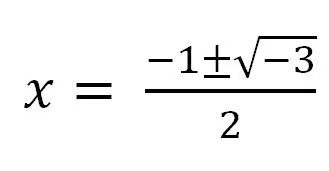
or

We can also use the identity i2 = -1 to rewrite the solutions as (-1 + √3i) / 2 and (-1 – √3i) / 2.
This quadratic equation has two complex solutions (they are complex conjugates).
Conclusion
Now you know the difference between a quadratic equation and the quadratic formula. You have also seen some examples and some non-examples to illustrate the idea of how to use the quadratic formula to solve a quadratic equation.
You might want to read my article on whether parabolas are one-to-one functions or my article on quadratic functions.
You might also want to read my article on when to use the quadratic equation or my article about how to factor a quadratic binomial (you can use a special case of the quadratic formula).
You might also want to check out my article on quadratic sequences.
I hope you found this article helpful. If so, please share it with someone who can use the information.
Don’t forget to subscribe to my YouTube channel & get updates on new math videos!
~Jonathon

